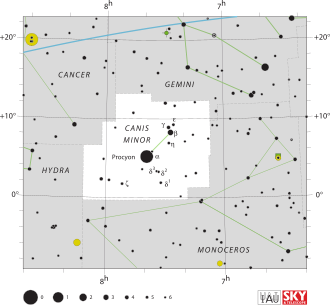Canis Minor
Canis Minor is a constellation in the northern sky. It is Latin for "smaller dog" or "the lesser dog". The astronomer Ptolemy listed it when he made a list of 48 constellations in the 2nd century. Both Canis Minor and Canis Major (which means "larger dog" in Latin) represent dogs that follow the hunter named Orion in Greek Mythology.[1]
 Click for larger image | |
| List of stars in Canis Minor | |
| Abbreviation: | CMi |
| Genitive: | Canis Minoris |
| Symbology: | |
| Right ascension: | 8 h |
| Declination: | +5° |
| Area: | 183 sq. deg. (71st) |
| Main stars: | 2 |
| Bayer/Flamsteed stars: | 14 |
| Stars known to have planets: | 1 |
| Bright stars: | 2 |
| Nearby stars: | 4 |
| Brightest star: | Procyon (α CMi) (0.34m) |
| Nearest star: | Procyon (α CMi) ( ly) |
| Messier objects: | 0 |
| Meteor showers: | Canis-Minorids |
| Bordering constellations: | |
| Visible at latitudes between +90° and −75° Best visible at 21:00 (9 p.m.) during the month of March | |
The main shape of Canis Minor is made by two stars, which are named Procyon (Alpha Canis Minoris) and Gomeisa (Beta Canis Minoris).[2] These stars are the only stars in Canis Minor that have a magnitude that is brigher than 4.[3] Procyon has a magnitude of 0.39, which means that it is the seventh brightest star in the night sky.[a] It is also very close to Earth, since it is only 11.4 light years away.[3] Procyon is a binary star, which means that it actually has two stars that orbit each other. It has a white dwarf star and a white type F5 main-sequence star.[4] Gomeisa has a magnitude of 2.9.[5] Its temperature is 11,500°K, which means that it is very hot. It is a blue type B8 main-sequence star. It is 3 times the mass of the sun and 250 times more luminous than the sun.
Canis Minor Media
Canis Minor, as depicted by Johann Bode in his 1801 work Uranographia
The constellation Canis Minor can be seen alongside Monoceros and the obsolete constellation Atelier Typographique in this 1825 star chart from Urania's Mirror.
Notes
- ↑ If the magnitudes of binary stars are combined, then Procyon is the eighth brightest star in the night sky.
References
- ↑ Ridpath, Ian. "Canis Minor: The Lesser Dog". Star Tales. Retrieved 27 January 2013.
- ↑ Kaler, Jim. "Canis Minor". Stars. Retrieved 28 January 2013.
- ↑ 3.0 3.1 "Procyon (HIP 37279)". Ashland Astronomy Studio. Archived from the original on 6 September 2013. Retrieved 28 January 2013.
- ↑ Kaler, Jim. "Pyrocyon". Stars. Retrieved 28 January 2013.
- ↑ Kaler, Jim. "Gomeisa". Stars. Retrieved 28 January 2013.



